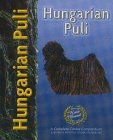
Hungarian Puli
Hungarian Pulis are not very well known in the UK, and stand out for their unusual appearance. They have long, black, 'dreadlocks'. They are often bought to be show dogs, because they look so striking, but they are herders, and are happiest when they are active. Pulis can develop behavioural problems if they aren't given enough to do. They are very good agility dogs, and also perform well in obedience competitions.
Pulis are wonderful dogs for people who want an active dog they can do agility with, and who are prepared to put training time in. These dogs respond very well to training, learning fast. They are happiest when kept busy, and their vices are typical of herding breeds - nipping and barking as part of their herding behaviour. Puli pups do need special attention with bite inhibition, and socialization should be ongoing, since Pulis can be a little wary of strangers, which usually means being barky. They are good watchdogs for this reason, since they will alert their owners to strangers. They are not especially good guard dogs, since they don't look very fearsome. There is a larger Hungarian relative of the Puli with a similar coat, the Komondor, which was used for flock guarding, and which makes a better guard dog.
Are they good with children? This depends. They can be a little nippy, and younger children might be tempted to pull on their cords, so they are better suited to families with older children, who respect them. Pulis can be a bit pushy, and children need to be brought into training programmes so that everyone teaches the dog the same house rules. They can also knock over smaller children, because they are so active, though this is less of a risk than with a larger active dog like a Bearded Collie.
One of the attractions of Hungarian Pulis is that they are generally very healthy. Hip dysplasia, cataracts, and urinary stones can affect some individuals, but generally this breed is long-lived, and stays active all its life. It's especially important to give them access to water, and moistened dry food is better than just dry, so their urine isn't too concentrated. Asprin is also not a good idea for these dogs.
A Puli's coat reaches the ground when full-grown, which takes some two to three years. Caring for the coat involves creating cords from matted underfur and the longer coarse hairs. Each cord has to be created by the owner. The coat doesn't need much care after the cords have formed, but it takes a long time to dry when it gets wet. Owners who just love the Puli's personality and don't want to show their dog could think of (gasp) trimming the coat just a little, so it isn't an encumbrance, picking up mud everywhere and taking hours to dry. It's human culture that has decided on the way a Puli wears its coat, as is true with the Poodle, and these dogs have too much to offer to be seen simply in terms of their coats.
Ann Arch's book is a very good, up-to-date introduction to the breed, which should interest all Puli owners. It's accessible enough for novice owners, and has enough detail to interest experienced owners. The book also has some lovely pictures of Pulis.



